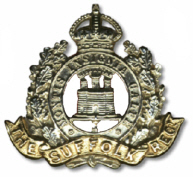



No.24880, Private, Harry Sidney CLARK (E)
Aged 31

|
Harry Clarke was born in Six Mile Bottom in 1885 (Newmarket Q3-1889 3B:520), baptised in Little Wilbraham on 15th November 1885, son of Charles and Ellen
CLARKE (née WEBB).
1891 census...Aged 5, he was at Brinkley Road, Six Mile Bottom, with his father Charles CLARKE [43] railway platelayer, born Westley; his mother Ellen [41] born Westley;brothers William [16] and Arthur [14] (farm labourers); sisters Florence [11], Elizabeth [7] and Annie [1]. All the children recorded as born in Six Mile Bottom. 1901 census...Aged 15, a farm labourer, he was at 1 Gate House, Six Mile Bottom with his parents and sisters Florrie and Annie. 1911 census...Aged 25, farm labourer, he was at Six Mile Bottom with his parents (father now a farm labourer) and cousin Alex NORTON [8] born in Dullingham. His mother had borne 15 children, but 10 had already died. |

|
He enlisted in Newmarket. The 11th Suffolks spent the early part of 1917 just south of Roclincourt, distributing stores, cutting wire and raiding, in preparation for the forthcoming Arras offensive, due to start on 9th April. As Harry Clarke and Clement Crisp from Griston in Norfolk were the only two of the battalion to die on the 3rd April 1917 it is possible they were part of this raiding party (although there is no report of casualties). The war diary has :- . "To obtain prisoners - point of entry G.12.a.53.93 - party 2/Lt Pulleyn, 2 sergeants 18 other ranks - Zero hour 4:15 am 3/4/17 - The party was formed up at the end of Sap 98 at 4 am. A Very light was seen to be fired from what was taken to be the point of entry: The party moved on this point. At zero they walked forward under the barrage and got within 40 yards of the front line before the barrage lifter. At plus 4 they entered the German trench. (1) "/Lt Pulleyn with 5 other ranks worked to the right from where a Very light had been fired just as they entered the trench/ I NCO and 1 man report having seen a man double back to the German support line from this direction. About 20 yards up the trench the right party found a bay, well revetted, and with a fire step. This bay was about a yard deeper than the rest of the trench and had in it a small dugout. On the firestep was a rifle which they brought back. (2) A Sgt with 8 other ranks worked to the left part of a communication trench but no sight of occupation. They went about 25 yards. (3) The remainder, left at point of entry,report that several Very lights were fired from Support trench and that more than one figure was seen doubling back from the front line.Evidence varies from 1 to 4 The return to our trenches was made without difficulty though a few shots were fired. No machine guns fired,though at zero minus 45 one had been very active. It is thought that our barrage was not strong enough to hold the enemy to their trench. It would seem that the front line is patrolled by men firing Very lights, and that sentry groups, if any, are far apart." |
Jumping off point for raid described above photo: Rodney Gibson photo:Rodney Gibson



click here to go to the Commonwealth War Graves Commission website for full cemetery/memorial details